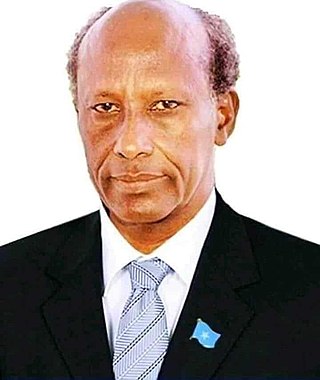
Mohamed Farrah Hassan Garad, known as General Aidid or Aideed was a Somali general and diplomat.

Mohammed Siad Barre was a Somali military officer, politician, and revolutionary who served as the Head of state of Somalia from 21 October 1969 to 26 January 1991.

The Somali Democratic Republic (Somali: Jamhuuriyadda Dimuqraadiya Soomaaliyeed; Arabic: الجمهورية الديمقراطية الصومالية, al-Jumhūrīyah ad-Dīmuqrāṭīyah aṣ-Ṣūmālīyah; was the name of the socialist totalitarian military government dictatorship given to Somalia under President Major General Mohamed Siad Barre, after seizing power in a coup d'état on 21 October 1969. The coup came a few days after a bodyguard assassinated Abdirashid Shermarke, the nation's second President. Barre's administration ruled Somalia for the next 21 years until Somalia collapsed into civil war in 1991.
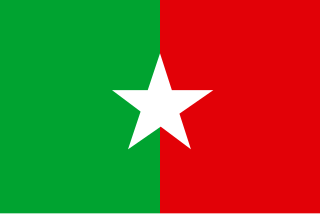
The Western Somali Liberation Front was a separatist rebel group fighting in eastern Ethiopia to liberate the Ogaden region from Ethiopian control. It played a major role in the Ogaden War of 1977–78, assisting the invading Somali Army.
The United Somali Congress (USC) was one of the major rebel organizations in Somalia. Formed in 1989, it played a leading role in the ouster of the government of Siad Barre in 1991, and became a target of the Unified Task Force campaign in 1993. Following infighting, the USC later splintered into smaller groups. By 2000, with the establishment of a Transitional National Government (TNG), a process of disarmament was put in motion and some moderate ex-USC leaders were incorporated into the new interim administration.

The Somali Civil War is an ongoing civil war that is taking place in Somalia. It grew out of resistance to the military junta which was led by Siad Barre during the 1980s. From 1988 to 1990, the Somali Armed Forces began engaging in combat against various armed rebel groups, including the Somali Salvation Democratic Front in the northeast, the Somali National Movement in the northwest, and the United Somali Congress in the south. The clan-based armed opposition groups overthrew the Barre government in 1991.

Mohammad Ali Samatar was a Somali military officer,politician, and former Commander-in-Chief of the Somali National Army. He was the only officer to reach the rank of Lieutenant General in the history of the Somali Armed Forces.
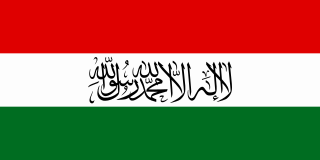
The Somali National Movement was one of the first and most important organized guerilla groups and Mujahideen groups that opposed the Siad Barre regime in the 1980s to the 1990s, as well as being the main anti-government faction during the Somaliland War of Independence. The organisation was founded in London, England, on April 6, 1981 by Hassan Isse Jama, Hassan Adan Wadadid, and Ahmed Mohamed Gulaid and other former Somali diplomats, who stated that initially the group's purpose was to overthrow the Siad Barre regime.
Following the civil war and the ensuing societal chaos, some factions managed to exert a degree of authority over certain regions of Somalia where they maintained broad, clan-based support. This allowed these factions to establish working administrations and eventually coherent states, and restored order to their regions. This occurred first in Puntland, Southwestern Somalia, Galmudug, Jubaland and finally Banadir.
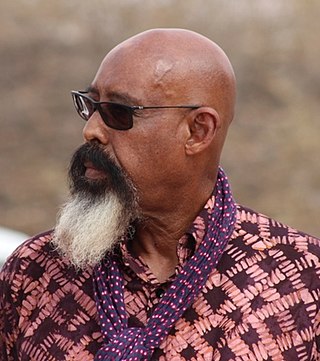
Major General Mohammed Said Hersi Morgan, also known as General Morgan or Colonel Morgan, is a Somali military and faction leader. He was the son-in-law of Siad Barre and Minister of Defence of Somalia. He hails from the Majeerteen Darood clan.
Over the course of the Somali Civil War, there have been many revolutionary movements and militia groups run by competing rebel leaders which have held de facto control over vast areas within Somalia.

The Somali Air Force is the air force of Somalia. Called the Somali Aeronautical Corps (SAC) during its pre-independence period (1954–1960), the Somali Air Force was renamed as such after Somalia gained independence in 1960. Ali Matan Hashi, Somalia's first pilot and person principally responsible for organizing the SAF, was its founder and served as its first Chief. At one point, the Somali Air Force had the strongest airstrike capability in the Horn of Africa. But by the time President Siad Barre fled Mogadishu in 1991, it had completely collapsed. The SAF headquarters was technically reopened in 2015.
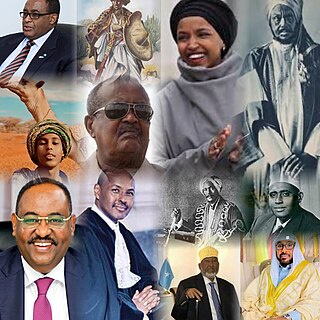
Osman Mahmoud is a Somali sub-clan and is one of the largest sub-clans within the major Majeerteen Harti confederation of Darod. The sub-clan is most renowned for its rich history within Somalia, That of which include sultanates such as the Majeerteen Sultanate and Hobyo Sultanate.
The 1982 Ethiopian–Somali Border War occurred between June and August 1982 when Ethiopia, sending a 10,000 man invasion force backed by warplanes and armored units, supported by thousands of SSDF rebels invaded Central Somalia. The United States government responded by speeding up deliveries of light arms and main battle tanks already promised. In addition, the initially pledged US$45 million in economic and military aid was increased to US$80 million.
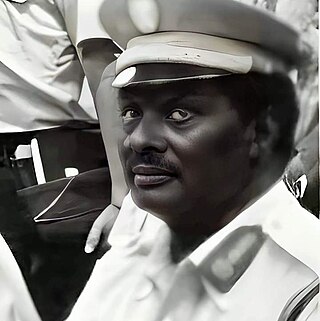
Aden Abdullahi Nur "Gabyow". was a very senior Somali, Military Officer, Faction Leader, Politician, a leading member and one of the most powerful men in the Somali Democratic Republic.

The Isaaq genocide, also known as the Hargeisa holocaust, was the systematic, state-sponsored genocide of Isaaq civilians between 1987 and 1989 by the Somali Democratic Republic, under the dictatorship of Siad Barre, during the Somaliland War of Independence. The number of civilian deaths in this massacre is estimated to be between 50,000 and 100,000, according to various sources, whilst local reports estimate the total civilian deaths to be upwards of 200,000 Isaaq civilians. The genocide also included the levelling and complete destruction of the second and third largest cities in the Somali Republic, Hargeisa and Burao, respectively, and had caused up to 500,000 Somalis of the region, primarily of the Isaaq clan, to flee their land and cross the border to Hartasheikh in Ethiopia as refugees in what was described as "one of the fastest and largest forced movements of people recorded in Africa", which resulted in the creation of the world's largest refugee camp then (1988), with another 400,000 being displaced. The scale of destruction led to Hargeisa being known as the 'Dresden of Africa'. The killings happened during the Somali Civil War and have been referred to as a "forgotten genocide".

The Somaliland Peace Process refers to the series of grassroot initiatives that brought peace to Somaliland after the collapse of central government of Somalia. In conjunction with the Somali National Movement, communities in Somaliland negotiated a series of truces to end hostilities and address the grievances between the communities who were often on opposing sides to the Barre regime.
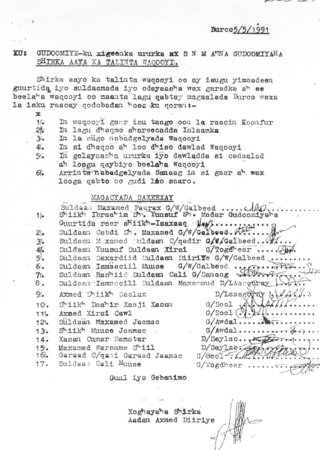
The Somaliland Declaration of Independence was made on 18 May 1991 by Somali sultans from the Isaaq, Dhulbahante, Issa, Gadabursi, Warsangali clans, as well as the Somali National Movement.

The Somaliland War of Independence was a rebellion waged by the Somali National Movement (SNM) against the ruling military junta in Somalia led by General Siad Barre lasting from its founding on 6 April 1981 and ended on 18 May 1991 when the SNM declared what was then northern Somalia independent as the Republic of Somaliland. The conflict served as the main theater of the larger Somali Rebellion that started in 1978. The conflict was in response to the harsh policies enacted by the Barre regime against the main clan family in Somaliland, the Isaaq, including a declaration of economic warfare on the clan-family. These harsh policies were put into effect shortly after the conclusion of the disastrous Ogaden War in 1978.
The 1988 Hargeisa-Burao offensive was a major offensive conducted during the Somaliland War of Independence in May 1988 by the Somali National Movement on the cities of Hargeisa and Burao, then the second and third largest cities of Somalia. The SNM captured Burao on 27 May within two hours, while the SNM entered Hargeisa on 29 May, overrunning most of the city apart from its airport by 1 June. During the offensive the Somali National Army committed gross human rights violations, including attacking the civilian population using heavy artillery and tanks.















